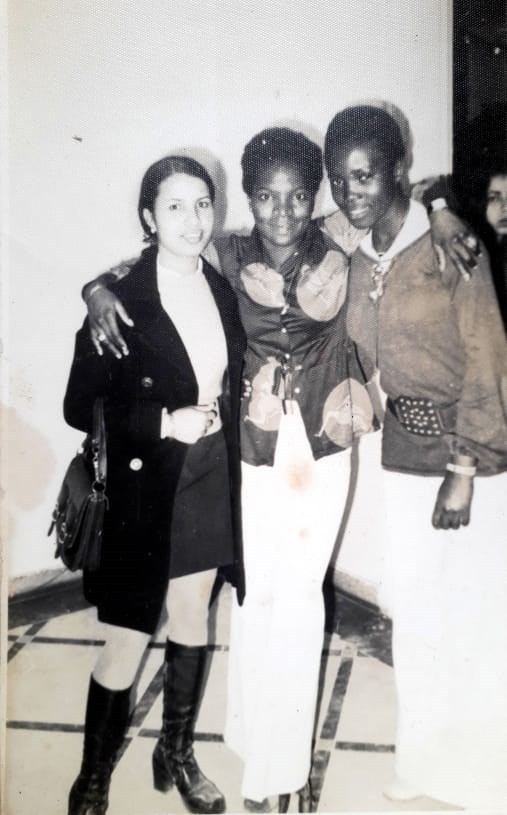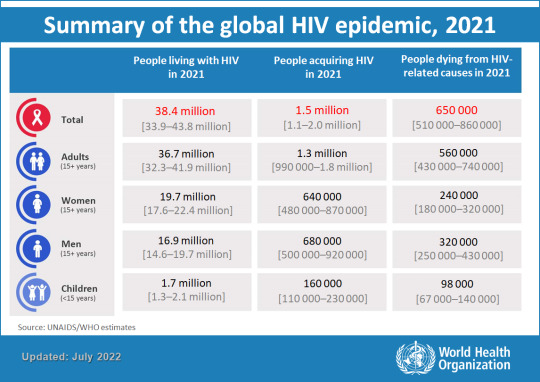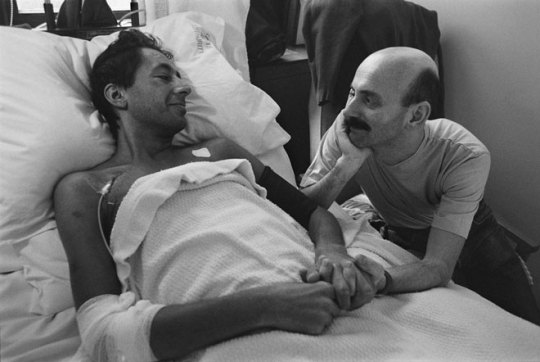#hiv/aids epidemic
Text
George W. Bush, the infamously anti-gay and neoconservative former U.S. president who invaded Iraq on a lie, has criticized congressional Republicans for threatening to defund the U.S. President’s Emergency Plan for AIDS Relief (PEPFAR), a largely successful African HIV-prevention program that he launched back in 2003. “There is no program more pro-life” than PEPFAR, he wrote.
Though PEPFAR is estimated to have saved over 25 million lives, its funding is set to expire on September 30. Congressional Republicans are falsely claiming that the program promotes abortion and using its re-funding as a bargaining chip in budget negotiations. Republicans have threatened to defund the entire federal government at the end of the month unless they’re allowed to slash military diversity programs and military aid to Ukraine and to increase anti-immigration measures at the U.S.-Mexico border.
“We are on the verge of ending the HIV/AIDS epidemic. To abandon our commitment now would forfeit two decades of unimaginable progress and raise further questions about the worth of America’s word,” Bush wrote in a Wednesday opinion article in The Washington Post.
Bush said that his Secretary of State Condoleezza Rice, his White House chief of staff Joshua Bolton, and his senior policy advisor Michael Gerson had advised him to begin PEPFAR. Gerson reportedly told Bush that it would be “a source of national shame” if the U.S. didn’t try to help end the worldwide HIV epidemic.
Bush’s opinion article cited words that Gerson himself had written in defense of PEPFAR in November 2017: “Are Republicans in Congress prepared to squander a legacy of GOP leadership that has won the United States considerable goodwill around the world? Among evangelical Christians, what definition of being ‘pro-life’ does not include saving millions of lives from preventable disease and death?”
Adding his own thoughts, Bush wrote, “There is no program more pro-life than one which has saved more than 25 million lives. I urge Congress to reauthorize PEPFAR for another five years without delay.”
During his presidency, Bush backed a constitutional amendment against same-sex marriage, and used bans on same-sex marriage to help him win re-election in 2004. While he served, 27 states banned same-sex marriage.
Despite Bush’s anti-gay record, PEPFAR was “a sound investment in U.S. security,” Ben Plumley, the former CEO of the now-defunct international HIV organization Pangea, said in a now-deleted interview with Hornet.com. Plumley said the program “generated very significant goodwill towards the United States” and countered “the spread of radical Islam or radical anti-Western attitudes in sub-Saharan Africa.”
Plumley also noted that most HIV transmissions in sub-Saharan Africa are heterosexual, meaning that conservative Republicans could support PEPFAR without worrying about seeming too overtly supportive of the LGBTQ+ community.
#us politics#news#lgbtq nation#2023#republicans#conservatives#president george w. bush#U.S. President’s Emergency Plan for AIDS Relief#pepfar#hiv/aids#hiv/aids epidemic#africa#world politics#the washington post#Condoleezza Rice#Joshua Bolton#Michael Gerson#Ben Plumley#bush administration#Hornet.com#us congress#congressional Republicans
157 notes
·
View notes
Link
When President George W. Bush invaded Iraq 20 years ago this week, I was in the middle of the smoke and chaos of that cataclysmic war that became his best-known legacy. I wrote countless columns opposing an invasion, then I was scathing as I covered the war, and I still see it as a practical and moral catastrophe.
But wait -- what if there’s something Bush did that was even more consequential than the invasion of Iraq? And what if it was something astonishingly good?
This is awkward, but I have to acknowledge that Bush deserves credit for the single best policy of any President in my lifetime. It’s called PEPFAR and if you haven’t heard of it, that’s part of the problem.
So my colleagues and I in New York Times Opinion made this video essay about an initiative that Bush created 20 years ago that saved 25 million lives. With the anniversary of the Iraq invasion, there’s lots of commentary about his miscalculations and failures, and there should be. But we liberals also have to acknowledge that the most important humanitarian program of modern times wasn’t started by a progressive we admire but by a conservative evangelical whose policies we deplored.
-- Nicholas Kristof, New York Times
#PEPFAR#Humanitarian Aid#History#Politics#Africa#AIDS#George W. Bush#President Bush#Bush 43#Bush Administration#Iraq War#Invasion of Iraq#New York Times#HIV/AIDS#President's Emergency Plan for AIDS Relief#AIDS in Africa#HIV/AIDS Epidemic#History is complicated
18 notes
·
View notes
Text

Marie Pierrette Béatrice Pono Ntyonga (right) with friends in Rabat, Morocco
B. November 14th 1954 in Port-Gentil (Mandji), Gabon
Béatrice studied general medicine at the Mohamed V University in Rabat, Morocco, where she graduated as valedictorian. In 1989, she specialized in Endocrinology-Metabolisms and Clinical Oncology. Béatrice became the first Gabonese woman to be awarded the title of Associate Professor of Medicine at the African and Malagasy Council for Higher Education (CAMES) Aggregation Competition in 2000, in Yaoundé, Cameroon.
Montréal, Québec
#Marie Pierrette Béatrice Pono Ntyonga#Maman Béa#Port-Gentil#Mandji#Libreville#Gabon#Rabat#Morocco#Montréal#Québec#Paris#France#Yaoundé#Cameroon#professor#endocrinology#endocrinologist#diabetologist#clinical oncology#hiv/aids epidemic#mother#wife#grandmother#beloved aunt and sister#may she rest in peace#<3
12 notes
·
View notes
Text
Globally, 38.4 million [33.9–43.8 million] people were living with HIV at the end of 2021.
Since the beginning of the epidemic, 84.2 million [64.0–113.0 million] people have been infected with the HIV virus and about 40.1 million [33.6–48.6 million] people have died of HIV.

Globally, 38.4 million [33.9–43.8 million] people were living with HIV at the end of 2021. An estimated 0.7% [0.6-0.8%] of adults aged 15–49 years worldwide are living with HIV, although the burden of the epidemic continues to vary considerably between countries and regions.
The WHO African Region remains most severely affected, with nearly 1 in every 25 adults (3.4%) living with HIV and accounting for more than two-thirds of the people living with HIV worldwide.
#World Health Organization (WHO)#hiv/aids#hiv infection#HIV/AIDS Responses#people living with hiv#hiv prevention#HIV/AIDS Epidemic
4 notes
·
View notes
Text

Dr. Gao Yaojie: Dissident doctor who exposed China's AIDS epidemic, dies at 95
Her work uncovered how businesses selling blood led to the spread of HIV in the countryside.
She was at the forefront of AIDS activism in China and traveled across the country treating patients, often at her own expense.
A gynecologist by training, she encountered her first AIDS patient in the central province of Henan in 1996.
While she was not the first Chinese doctor to expose the AIDS epidemic, it was her efforts that made the situation known to the country and beyond.
She told the Associated Press in a previous interview that she withstood government pressure and persisted in her work because “everyone has the responsibility to help their own people. As a doctor, that’s my job. So it’s worth it.”

#gao yaojie#doctor#author#activist#aids activist#aids activism#aids#hiv#blood transfusion#aids epidemic#aids crisis#china#healthcare#health care#1996#1990s#90s#2023
254 notes
·
View notes
Text









"let love replace fear through you."
AIDS QUILT SERIES | VIEW THE QUILT
#*aq#aids quilt#aids activism#hiv aids#act up fight aids#fight aids#aids#hiv/aids#aids epidemic#lgbtq#lgbtq history#lgbt history#queer history#i see that some folks have found my quilt tag & are reblogging.#& it inspired me to make another post before pride month is out.#thank you to everyone who reblogs one of these posts. i mean that.#thank you for taking a moment to love those who were taken.#anyway it was so hard to choose a tagline for this particular one...#' the face of the world has been changed forever. '#' our hearts will always be together. '#' i'm still alive! '#' for all the women. '#' for david who loved the minnesota prairie. '#' for everyone... love amy. '#& i feel you amy.#for everyone indeed.
424 notes
·
View notes
Text
@hungarianmudkip69 recently asked @vaspider about the spread of HIV. The excellent discussion there focused largely on qualitative aspects, notably what was going on socially in the 1970s and 80s, HIV's subtlety and long incubation periods, and exponential growth (along with a great refutation of accidental needle sticks as a dominant vector).
I've got a math and physics background - I have some extremely relevant intuition, but I still prefer being able to find real-world numbers to confirm that I haven't misapplied it. I encourage checking out all the links in this post; there's a lot of great information!
We can't literally go back in time and test everyone for HIV, but it is possible to model and estimate, e.g. this 2021 report from the CDC (US-only).
The second graph of figure #2 is very close to what we discussed:

(MMSC is male-to-male sexual contact and IDU is injection drug use; see the article for other details.)
Again, these are estimates, so we can't take the exact numbers as fact, but let's look at the big picture. HIV likely first arrived in the US around 1970; it first gained public attention in 1981, when the CDC reported cases of what we now call AIDS. At that point, the estimate is an order of magnitude of tens of thousands of HIV infections.
The original asker was interested in the behavior of a "patient zero" (see also "Debunking the Myth of Patient Zero", an excellent video linked in that thread). These numbers help us see how little effect one hypothetical person's behavior could have had on the end result. As long as the virus was transmitted at all, it was going to reach the highest-risk populations eventually, and spread once there, whether it took one hop or ten. It was also essentially impossible to notice the pattern and infer the existence of HIV/AIDS in the US until multiple people in the same community developed AIDS and contracted unusual infections - which most likely means that it's reached that high-risk population, and ten years have passed.
Tens of thousands of infections is simply the result of exponential growth during those ten years; stopping it from becoming an epidemic would've required everyone's behavior to have changed. Different behavior, different transmission, different number of hops early on would more likely have changed how long it took to spread widely enough to become noticeable, not whether it did. (An unfortunately familiar concept, in the year 2023.)
The authors also mention that "trend data comparing subpopulations is likely to be robust for each period examined", so let's look back at those individual lines. Injection drug use (IDU) actually was a fairly significant means of transmission by the 1980s, and by the mid-80s, the spread among gay/bi men (MMSC) was beginning to decline. At the end of the decade, IDU may even have passed MMSC. Simultaneously, transmission was still rising among straight people. It shouldn't be too surprising that straight sex became significant; there are rather a lot of straight people!
The CDC also has us covered for a more current picture, as of 2017-2021 in the US:

This does vary greatly by country. Notably, as of 2022 in England, 49% of new diagnoses were among heterosexuals, compared to 45% among gay/bi men. (Do keep in mind that there are far more straight people, so still, a far higher fraction of gay/bi men were diagnosed.)
I personally find that I get the best understanding when I'm able to combine some direct evidence/data with an understanding of the history and social forces; hopefully this piece helps at least one person out in that way!
[Finally, as a footnote: trans women also exist (hi I'm one) and have historically been at high risk. I am unsure to what extent trans women are omitted versus misgendered in the above data. I wanted to focus on historical estimates over time here, and unfortunately wasn't able to find that for trans women, but this review article links to and summarizes some data from two meta-analyses.]
120 notes
·
View notes
Text
"The “Düsseldorf Patient”, a man now aged 53, is just the third person worldwide to have been completely cured of HIV via stem cell transplantation.
As in the case of the other two patients, the so-called “Berlin Patient” and “London Patient,” the transplantation was undertaken to treat an acute blood disease, which had developed in addition to the HIV infection.
The Düsseldorf Patient received a stem cell transplant used to treat leukemia in 2013 and has shown persistent suppression of HIV-1 ever since, including during the last 4 years after the patient stopped taking anti-retroviral medication.
“I still remember very well the sentence from my family doctor: ‘don’t take it so hard,'” the Düsseldorf Patient, who had leukemia as well as HIV-1, said in a statement. “‘We will experience together that HIV can be cured!’ At the time, I dismissed the statement.”
Allogeneic hematopoietic stem cell transplantation (HSCT) is a procedure used to treat certain cancers, such as leukemia, by transferring immature blood cells from a donor to repopulate the bone marrow of the recipient.
Scientists now understand that individuals with two copies of the Δ32 mutation in the gene for the HIV-1 co-receptor CCR5; are resistant to HIV-1 infection. The two previous cases of both the London patient and the Berlin patient involved receiving a stem cell transplant from a donor with these unique mutations.
Björn-Erik Jensen, a specialist in infectious diseases at Düsseldorf University Hospital, lead the treatment and subsequent research, revealed today in a peer-reviewed study in Nature.
The patient was diagnosed as having acute myeloid leukemia and proceeded to undergo transplantation of stem cells from a female donor in 2013, followed by chemotherapy and infusions of donor lymphocytes.
After the transplantation, anti-retroviral therapy was continued, but HIV was undetectable in the patient’s blood cells. Anti-retroviral therapy was suspended in November 2018 with the patient’s informed consent, almost 6 years after the stem cell transplantation, to determine whether the virus persisted in the patient.
“I very much hope that these doctors will now get even more attention for their work,” said the patient. “I have now decided to give up some of my private life to support research fundraising. And of course, it will also stay very important for me to fight the stigmatization of HIV with my story.”
The authors conclude that although HSCT remains a high-risk procedure that is at present an option only for some people living with both HIV-1 and hematological cancers, these results may inform future strategies for achieving long-term remission of HIV-1."
-via Good News Network, 2/20/23
VERIFIED 10 YEARS ON, PROOF THAT HIV IS CURABLE
#hiv#health care#hiv aids#aids epidemic#aids crisis#lgbtq#lgbtq history#queer#queer history#hiv treatment#sex ed#medical news#medical research#good news#hope#I know he's not the first person we found cured of hiv#but as they say#three is a pattern#ANY increase in sample size at this stage is absolutely historical
398 notes
·
View notes
Text
I think the comment about only the boring gays living through the aids epidemic really got me angry because well it's acephobic for one thing and it does dismiss the trauma of those who lived through it.
But also like the people who lived were just... i don't want to say luck but i do want to say there was most likely no rhyme or reason for it. Which is why it probably hurts a lot of people, and i don't know how after living through covid 19 you could say it is anything but!
Sure there were some people who were foolish during covid, but that's not everyone and it's just victim blaming.
It's a tragedy.
#james somerton#todd in the shadows#hbomberguy#queer#covid#aids epidemic#not to mention those who got hiv after it was treatable#those people aren't bad either
71 notes
·
View notes
Text
You might assume that Dr. Anthony Fauci, after 54 years working at the National Institutes of Health and helping save countless lives, has retired so he can rest. However, Dr. Fauci doesn’t have time to retire.
Last month, Fauci joined Georgetown University School of Medicine’s Department of Medicine in the Division of Infectious Diseases as a Distinguished Professor. He was also appointed to the university’s McCourt School of Public Policy.
“I’ve also been busy lecturing and writing my memoir, and since I’ve been out of the NIH for seven months, I’m not following the ins and outs of the government, but I am paying attention to what’s going on with PEPFAR,” he tells me.
PEPFAR is the U.S. President’s Emergency Plan for AIDS Relief, which was signed into law 20 years ago this summer by President George W. Bush. It serves as a conduit to providing HIV medications to individuals in impoverished nations who would otherwise lack access to these drugs.
When I spoke to Fauci a couple years ago on the 40th anniversary of the discovery of HIV, he cited the opportunity to be the architect of the program as one of his greatest achievements. "It is the largest commitment by any nation to address a single disease in history," he told me. "It's been an honor to help lead this. I really value my participation in this program that has already saved 15-18 million (in 2021) lives around the world."
“PEPFAR impact has been truly remarkable,” Fauci told me during our phone call Friday evening. "It is one of this country’s greatest global health policies in history. It’s been a resounding success, and has saved at least 25 million lives worldwide and it provides antiretroviral treatments for over 20 million people worldwide.”
However, groundless claims from anti-abortion activists have put the program in jeopardy. Conservative and anti-abortion groups sent a letter to Republicans in Congress who are responsible for PEPFAR’s reauthorization. The letter said that PEPFAR funds are “used by nongovernmental organizations that promote abortions and push a radical gender ideology abroad.” They provided no evidence to back their claim.
Also, the ultra-conservative Heritage Foundation released a report that said Congress needs to “reassess” PEPFAR. The report claimed, “The Biden Administration has misused the program as a well-funded vehicle to promote its domestic radical social agenda overseas, as it has done with other foreign aid programs.” This so-called report also did not provide any proof.
As a result, Republicans in Congress are threatening not to reauthorize the program.
“The idea that this program would be interrupted, despite its overwhelming success, is unfortunate,” Fauci said. “There’s a real danger to associate the program with cultural issues as opposed to scientific ones that clearly show PEPFAR is saving lives.”
“It seems paradoxical that abortion rights groups who fight for life want to interfere with a program that has saved millions of lives,” Fauci pointed out. “If the program doesn’t function, lives aren’t saved, millions of them.”
Instead of castigating the program, shouldn't these groups, as well as all Americans, be celebrating the 20th anniversary of this milestone? “What’s ironic is that it was signed into law by a conservative Republican President, and it is without question George W. Bush’s greatest achievement. It took years to put together, in a bipartisan way, and it is one of the world’s signature global health initiatives. The thought of it not being authorized is not only dangerous, but disastrous.”
#us politics#news#advocate#advocate.com#2023#republicans#conservatives#us house of representatives#National Institutes of Health#Dr. Anthony Fauci#Georgetown University School of Medicine#PEPFAR#aids epidemic#hiv/aids#HIV medications#anti-abortion activists#heritage foundation#Biden Administration#president george w. bush#international aid
124 notes
·
View notes
Text
thinking about queer!house, who would’ve been just getting out of medical school at the beginning of the AIDS epidemic. house who loves puzzles and mysterious diseases. who probably did have to interview patients when he was younger and didn’t have the reputation to back up his behavior, having to deliver a diagnosis of GRID, that has only experimental treatments, a mysterious disease that nobody will fund the research for. the medical community can’t even agree on why exactly people catch it or on how it’s transmitted at first.
in the hallways, the unspoken consensus is that it’s spread through deviancy. degeneracy. queer behavior. that it’s more social contagion than real disease.
it would’ve made him furious. to watch people die, over and over again, from a puzzle that those with power didn’t want to solve. to hear so many become indignant or furious or hysterical at a diagnosis that labels them as queer. maybe it was worse to see those visibly gay men who only nodded their head, accepted that what had already begun killing their friends, their lovers, was killing them too.
everybody lies. whether they’re lying about their sexuality or lying about accepting an awful death shouldn’t make a difference to him. they’re going to die irregardless.
i think living through the epidemic as a young queer man would give additional explanation to a lot of house’s behavior. his general distaste for and mistrust for authority, his willingness to try any treatment no matter how radical or experimental, his conscious refusal to connect emotionally with patients, even down to less obvious stuff, like his consistent refusal to use heroin. he’s genuinely traumatized from living through an epidemic that killed people like him.
#i just think it would explain soo much abt him#he hates everyone around him a little too much for somebody that hasnt been through hell#stacy says he’s always been a jerk but cuddy notably doesn’t#cuddy knew him in college. stacy met him at a conference after he was alr a doctor#and i think obviously house was always kind of an asshole#but i think living thru the epidemic wouldve changed him#wilson wouldve been affected by it too#but he wouldve more seen the moral panic and such#he wouldve been in high school/college at its height#and by the time he gets out of med school HIV is a diagnosis and there is much more public knowledge about it#different perspectives on it idk#been thinking abt this a lot recently#house md#greg house#house md headcanon#tw HIV#tw AIDS epidemic#house md hc
144 notes
·
View notes
Photo




AIDS patients with their loved ones, 1993 (Gideon Mendel, The Ward)
#aids#hiv#lgbt history#queer history#gay history#gideon mendel#photography#black and white#b&w photography#aids epidemic#intimacy
177 notes
·
View notes
Text
Building back better in a post-pandemic world must include HIV responses that are evidence-based, people-centred, resilient, sustainable and, above all, equitable.
“To close the gaps, these initiatives must be delivered through a reinforced health care system and meaningful engagement of all affected communities, especially the most vulnerable.” said fore
A prolonged COVID-19 pandemic is deepening the inequalities that have long driven the HIV epidemic, UNICEF warns Ahead of World AIDS Day.
2 notes
·
View notes
Text
"Offer God anything to bring your brother back. / Know you have nothing God could possible want."
Read it here | Reblog for a larger sample size!
#closed polls#polls#poetry#poems#poetry polls#poets and writing#tumblr poetry#have you read this#michael lassell#lgbt#queer poetry#hiv/aids#aids epidemic
30 notes
·
View notes
Text

#hiv/aids#hivpositive#health care#discrimination#sex ed#aids#hiv aids#hiv stigma#aids activism#disability aids#sleep aids#band aids#aids crisis#lgbtq history#aidsawareness#aids epidemic#aids quilt#republicans#christianity#religion#catholicism#theology#religious#catholic
101 notes
·
View notes
Photo

Jimmy DeSana indulged in tongue-in-cheek humor and riffed on historical avant-gardes.
In 1984, DeSana’s spleen ruptured, resulting in a life-changing surgery and his diagnosis with human immunodeficiency virus (HIV). While his health deteriorated over the next six years living with acquired immunodeficiency syndrome (AIDS), this period was one of his most productive.
His movement into abstraction—in works that nonetheless address his experience living with HIV/AIDS—countered the objectification of queer bodies in voyeuristic epidemic-related art and news campaigns. It also resisted polarized debates over sexuality and its representations. DeSana embraced opacity and ambiguity in response to binary thinking, and infused mainstream and historic content with a queer perspective.
View the nearly 200 works from this prolific artist in Jimmy DeSana: Submission during the final weekend of the exhibition.
📷 Jimmy DeSana (American, 1949–1990). Aluminum Foil #4 (Self-Portrait), 1985. Silver dye bleach print, 10 × 8 in. (25.4 × 20.3 cm). Courtesy of the Jimmy DeSana Trust and P·P·O·W Gallery, New York. © Estate of Jimmy DeSana. (Photo: Courtesy of the Jimmy DeSana Trust and P·P·O·W Gallery, New York)
#Brooklyn Museum#JimmyDeSanaBkM#Jimmy DeSana#exhibition#art#museum#photography#photographer#artist#HIV#hiv/aids#aids epidemic#lgbtq+#New York City#nyc#sexuality
48 notes
·
View notes